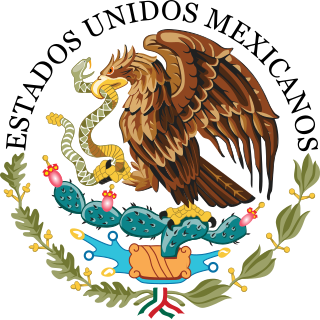
The politics of Mexico function within a framework of a federal presidential representative democratic republic whose government is based on a multi-party congressional system, where the President of Mexico is both head of state and head of government. The federal government represents the United Mexican States and is divided into three branches: executive, legislative and judicial, as established by the Political Constitution of the United Mexican States, published in 1917. The constituent states of the federation must also have a republican form of government based on a congressional system as established by their respective constitutions.

The Institutional Revolutionary Party is a political party in Mexico that was founded in 1929 and held uninterrupted power in the country for 71 years, from 1929 to 2000, first as the National Revolutionary Party, then as the Party of the Mexican Revolution and finally as the PRI beginning in 1946.

The National Action Party is a conservative political party in Mexico founded in 1939. The party is one of the main political parties in Mexico, and since the 1980s has had success winning local, state, and national elections.

The Party of the Democratic Revolution is a social democratic political party in Mexico. The PRD originated from the Democratic Current, a political faction formed in 1986 from the Institutional Revolutionary Party (PRI). The PRD was formed after the contested general election in 1988, which the PRD's immediate predecessor, the National Democratic Front, believed was rigged by the PRI. This sparked a movement away from the PRI's authoritarian rule.

The Congress of the Union, formally known as the General Congress of the United Mexican States, is the legislature of the federal government of Mexico consisting of two chambers: the Senate of the Republic and the Chamber of Deputies. Its 628 members meet in Mexico City.

The House of Representatives is the lower house of the Congress of the Union, the bicameral parliament of Mexico. The other chamber is the Senate. The structure and responsibilities of both chambers of Congress are defined in Articles 50 to 70 of the constitution.

The Ecological Green Party of Mexico is a green political party in Mexico.

General elections were held in Mexico on Sunday, 2 July 2000. Voters went to the polls to elect a new president to serve a single six-year term, replacing President Ernesto Zedillo Ponce de León, who was ineligible for re-election under the 1917 Constitution. The election system ran under plurality voting; 500 members of the Chamber of Deputies for three-year terms and 128 members of the Senate for six-year terms.

Roberto Madrazo Pintado is a Mexican politician, member of the Institutional Revolutionary Party. He was the candidate of the alliance between his party and the Ecologist Green Party of Mexico (PVEM) in the 2006 Mexican presidential election.

The Labor Party is a political party in Mexico. It was founded on 8 December 1990. The party is currently led by Alberto Anaya.
Pemexgate was a political scandal of the Mexican political party PRI that occurred during the presidency of Ernesto Zedillo (1994-2000) and was discovered and investigated during the presidency of Vicente Fox (2000-2006). It was centered on the transfer of 500 million pesos to the PRI candidate for the 2000 Presidential Elections, Francisco Labastida Ochoa, from Pemex, Mexico's national oil company.
Elections in the Mexican Federal District were held on Sunday, 2 July 2006. Voters went the polls to elect, on the local level:

The LX Legislature (60th) of the Congress of Mexico met from September 1, 2006, to September 1, 2009. All members of both the lower and upper houses of Congress were elected in the elections of July 2006.

General elections were held in Mexico on 21 August 1994. The presidential elections resulted in a victory for Ernesto Zedillo of the Institutional Revolutionary Party (PRI), whilst the PRI won 300 of the 500 seats in the Chamber of Deputies and 95 of the 128 seats in the Senate. Voter turnout ranged from 77.4% in the proportional representation section of the Chamber elections to 75.9% in the constituency section.

Legislative elections were held in Mexico on 6 July 1997. The Institutional Revolutionary Party won 239 of the 500 seats in the Chamber of Deputies, the first time it had failed to win a majority. As a result, the leaders of the Party of the Democratic Revolution and of the National Action Party were able to control Congress and installed PRD member Porfirio Muñoz Ledo as the president of the Chamber of Deputies. At first, the PRI refused to accept the nomination and its parliamentary leader, Arturo Núñez Jiménez, declared it illegal. However, the PRI later accepted the fact and Muñoz Ledo answered the state of the union address of President Ernesto Zedillo.

Manuel Andrade Díaz is a Mexican politician affiliated with the Institutional Revolutionary Party PRI and former Governor of Tabasco. He holds a law degree from the University Juárez Autónoma of Tabasco and qualified in Electoral Law and Parliamentary Law.

General elections were held in Mexico on 1 July 2018. Voters elected a new President of Mexico to serve a six-year term, 128 members of the Senate for a period of six years and 500 members of the Chamber of Deputies for a period of three years. It was one of the largest election days in Mexican history, with most of the nation's states holding state and local elections on the same day, including nine governorships, with over 3,400 positions subject to elections at all levels of government. It was the most violent campaign Mexico has experienced in recent history, with 130 political figures killed since September 2017.
Guadalupe Acosta Naranjo is a Mexican politician affiliated with the Party of the Democratic Revolution. He represents Nayarit and the first electoral region as a deputy to the LXIII Legislature of the Mexican Congress.

Legislative elections were held in Mexico on 6 June 2021. Voters elected 500 deputies to sit in the Chamber of Deputies for the 65th Congress. These elections took place concurrently with the country's state elections.




















